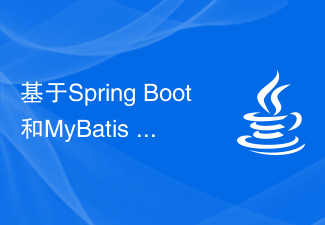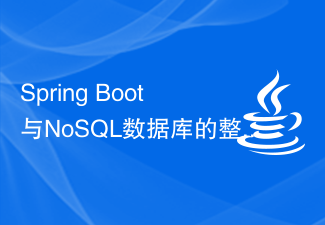 Java
Java javaTutorial
javaTutorial Technical practice of Docker and Spring Boot: quickly build high-performance application services
Technical practice of Docker and Spring Boot: quickly build high-performance application services
Technical practice of Docker and Spring Boot: quickly build high-performance application services
Introduction:
In today's information age, the development of Internet applications Development and deployment are becoming increasingly important. With the rapid development of cloud computing and virtualization technology, Docker, as a lightweight container technology, has received widespread attention and application. Spring Boot has also been widely recognized as a framework for rapid development and deployment of Java applications.
This article will discuss how to combine Docker and Spring Boot to quickly build high-performance application services. We will use specific code examples to show how to use Docker containerization to deploy Spring Boot applications and take advantage of Docker to improve application performance and maintainability.
1. Introduction to Docker
Docker is an open source container technology platform that can package applications and their dependencies into a portable container and then deploy it to any environment that supports Docker . The core concepts of Docker are images and containers. Images are used to build containers, and a container is an instance of an image. Through Docker's images and containers, we can quickly deploy applications and solve dependency issues between applications.
2. Introduction to Spring Boot
Spring Boot is part of the Spring framework, which simplifies the development and deployment of Spring applications. Spring Boot provides some automatic configuration functions that can help us quickly build independent, executable Java applications. Through Spring Boot, we can package Java applications into a separate executable JAR file for easy deployment and management.
3. Use Docker containerization to deploy Spring Boot applications
The following is a simple Spring Boot sample application, which implements a simple RESTful API:
@SpringBootApplication
@RestController
public class Application {
@RequestMapping("/hello")
public String hello() {
return "Hello, Docker and Spring Boot!";
}
public static void main(String[] args) {
SpringApplication.run(Application.class, args);
}
}Next , we will use Docker containerization to deploy this Spring Boot application.
- Create Dockerfile
First, we need to create a file named Dockerfile in the root directory of the application to define the building rules of the Docker image. In the Dockerfile, we need to specify the base image, exposed port number and application running command.
The following is a simple Dockerfile example:
FROM openjdk:8-jdk-alpine VOLUME /tmp COPY target/app.jar app.jar ENTRYPOINT ["java","-jar","app.jar"] EXPOSE 8080
- Build Docker image
In the root directory of the project, execute the following command to build the Docker image :
docker build -t myapp .
- Run the Docker container
After building the Docker image, we can run the Docker container through the following command:
docker run -d -p 8080:8080 myapp
Now, we can pass Visit http://localhost:8080/hello to test the Spring Boot application.
4. Advantages and practical suggestions
By combining Spring Boot applications with Docker containers, we can gain the following advantages:
- Rapid deployment: through Docker containers, We can quickly deploy and start applications, avoiding cumbersome environment configuration and dependency issues.
- Flexible expansion: Through Docker containers, we can easily expand horizontally the application to achieve higher performance and availability.
- Resource isolation: Through Docker containers, we can achieve resource isolation between applications and avoid conflicts and interference between applications.
In practice, we recommend the following:
- Use an appropriate base image: Choosing an appropriate base image can reduce the time and resource consumption of building an image. At the same time, pay attention to the security and stability of the base image.
- Optimize the size of the image: By rationally selecting dependencies and configuration files, you can reduce the size of the image and avoid unnecessary waste of resources.
- Use orchestration tools to manage containers: In a production environment, we recommend using some orchestration tools (such as Docker Compose, Kubernetes, etc.) to manage and monitor Docker containers to improve the stability and maintainability of applications.
Summary:
This article introduces how to combine Docker and Spring Boot to quickly build high-performance application services. Through specific code examples, we show how to use Docker containerization to deploy Spring Boot applications, and give corresponding advantages and practical suggestions. I hope this article helps you use Docker and Spring Boot in practice.
The above is the detailed content of Technical practice of Docker and Spring Boot: quickly build high-performance application services. For more information, please follow other related articles on the PHP Chinese website!
 Spring Boot Actuator从未授权访问到getshell的示例分析May 23, 2023 am 08:56 AM
Spring Boot Actuator从未授权访问到getshell的示例分析May 23, 2023 am 08:56 AM前言部门大佬在某src上挖到了这个漏洞,是一个比较老的洞了,我觉得有点意思,就动手在本地搭了个环境测试一下。Actuator是springboot提供的用来对应用系统进行自省和监控的功能模块,借助于Actuator开发者可以很方便地对应用系统某些监控指标进行查看、统计等。在Actuator启用的情况下,如果没有做好相关权限控制,非法用户可通过访问默认的执行器端点(endpoints)来获取应用系统中的监控信息,从而导致信息泄露甚至服务器被接管的事件发生。如上所示,actuator是springb
 如何利用Spring Boot构建区块链应用和智能合约Jun 22, 2023 am 09:33 AM
如何利用Spring Boot构建区块链应用和智能合约Jun 22, 2023 am 09:33 AM随着比特币等数字货币的兴起,区块链技术也逐渐成为热门话题。而智能合约,则可视为区块链技术的重要组成部分。SpringBoot作为一种流行的Java后端开发框架,也能够用来构建区块链应用和智能合约。本文将介绍如何利用SpringBoot搭建基于区块链技术的应用和智能合约。一、SpringBoot与区块链首先,我们需要了解一些与区块链相关的基本概念。区块链
 基于Spring Boot和MyBatis Plus实现ORM映射Jun 22, 2023 pm 09:27 PM
基于Spring Boot和MyBatis Plus实现ORM映射Jun 22, 2023 pm 09:27 PM在Javaweb应用开发过程中,ORM(Object-RelationalMapping)映射技术用来将数据库中的关系型数据映射到Java对象中,方便开发者进行数据访问和操作。SpringBoot作为目前最流行的Javaweb开发框架之一,已经提供了集成MyBatis的方式,而MyBatisPlus则是在MyBatis的基础上扩展的一种ORM框架。
 使用Spring Boot和Apache ServiceMix构建ESB系统Jun 22, 2023 pm 12:30 PM
使用Spring Boot和Apache ServiceMix构建ESB系统Jun 22, 2023 pm 12:30 PM随着现代企业越来越依赖于各种不同的应用程序和系统,企业集成变得愈发重要。企业服务总线(ESB)就是一种集成架构模式,通过将不同系统和应用程序连接在一起,提供通用的数据交换和消息路由服务,从而实现企业级应用程序集成。使用SpringBoot和ApacheServiceMix,我们可以轻松构建一个ESB系统,这篇文章将介绍如何实现。SpringBoot和A
 基于Spring Boot的分布式数据缓存和存储系统Jun 22, 2023 am 09:48 AM
基于Spring Boot的分布式数据缓存和存储系统Jun 22, 2023 am 09:48 AM随着互联网的不断发展和普及,数据的处理和存储需求也越来越大,如何高效且可靠地处理和存储数据成为了业界和研究人员的热门话题。基于SpringBoot的分布式数据缓存和存储系统是近年来备受关注的一种解决方案。什么是分布式数据缓存和存储系统?分布式数据缓存和存储系统是指通过多个节点(服务器)分布式地存储数据,提高了数据的安全性和可靠性,同时也可以提升数据的处理性
 Spring Boot与NoSQL数据库的整合使用Jun 22, 2023 pm 10:34 PM
Spring Boot与NoSQL数据库的整合使用Jun 22, 2023 pm 10:34 PM随着互联网的发展,大数据分析和实时信息处理成为了企业的一个重要需求。为了满足这样的需求,传统的关系型数据库已经不再满足业务和技术发展的需要。相反,使用NoSQL数据库已经成为了一个重要的选择。在这篇文章中,我们将讨论SpringBoot与NoSQL数据库的整合使用,以实现现代应用程序的开发和部署。什么是NoSQL数据库?NoSQL是notonlySQL
 使用Spring Boot和JavaFX构建桌面应用程序Jun 22, 2023 am 10:55 AM
使用Spring Boot和JavaFX构建桌面应用程序Jun 22, 2023 am 10:55 AM随着技术的不断发展,我们现在可以使用不同的技术来构建桌面应用程序。而SpringBoot和JavaFX则是现在较为流行的选择之一。本文将重点介绍如何使用这两个框架来构建一个功能丰富的桌面应用程序。一、介绍SpringBoot和JavaFXSpringBoot是一个基于Spring框架的快速开发框架。它可以帮助开发者快速构建Web应用程序,同时提供一组开
 Spring Boot的任务调度和定时任务实现方法Jun 22, 2023 pm 11:58 PM
Spring Boot的任务调度和定时任务实现方法Jun 22, 2023 pm 11:58 PMSpringBoot是一款非常流行的Java开发框架,不仅具有快速开发的优势,而且还内置了很多实用的功能,其中,任务调度和定时任务就是其常用的功能之一。本文将探讨SpringBoot的任务调度和定时任务实现方法。一、SpringBoot任务调度简介SpringBoot任务调度(TaskScheduling)是指在特定的时间点或某个条件下,执行一些特


Hot AI Tools

Undresser.AI Undress
AI-powered app for creating realistic nude photos

AI Clothes Remover
Online AI tool for removing clothes from photos.

Undress AI Tool
Undress images for free

Clothoff.io
AI clothes remover

AI Hentai Generator
Generate AI Hentai for free.

Hot Article

Hot Tools

Dreamweaver CS6
Visual web development tools

SAP NetWeaver Server Adapter for Eclipse
Integrate Eclipse with SAP NetWeaver application server.

mPDF
mPDF is a PHP library that can generate PDF files from UTF-8 encoded HTML. The original author, Ian Back, wrote mPDF to output PDF files "on the fly" from his website and handle different languages. It is slower than original scripts like HTML2FPDF and produces larger files when using Unicode fonts, but supports CSS styles etc. and has a lot of enhancements. Supports almost all languages, including RTL (Arabic and Hebrew) and CJK (Chinese, Japanese and Korean). Supports nested block-level elements (such as P, DIV),

PhpStorm Mac version
The latest (2018.2.1) professional PHP integrated development tool

Dreamweaver Mac version
Visual web development tools




